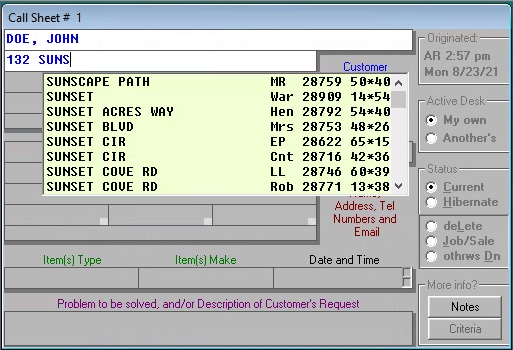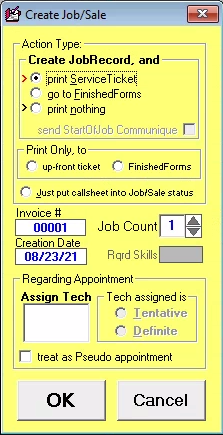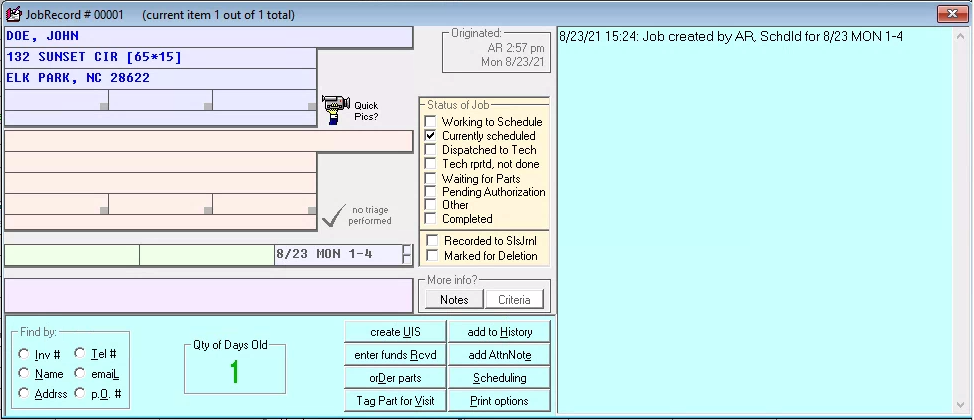Beginning Tour
To develop your understanding of ServiceDesk somewhat more systematically (particularly of its basic call-taking and dispatch functions), you’re now invited to try a hands-on exercise where we'll pretend, essentially, that it's a typical day in your office, with you using ServiceDesk to respond to the ordinary and ongoing minute-by-minute needs of business. For this purpose, we must assume you are the secretary today, whether that's truly your job or not.
Receiving your first call
Your first pretend call is from a Mr. John Doe, who says he has a leaky dishwasher. Go ahead: on the first line in your first ServiceDesk Callsheet, type DOE, JOHN. After doing so, hit Enter on your keyboard (or Tab if you prefer) to move to the Callsheet’s next line.
Notice that here it is very important to use the formal last-name, first-name. This is because we’re going to be looking up customer’s records, in various contexts, on the basis of the last name. You might notice we’re also entering in all upper-case. The reason is economy. Unlike in the Settings form (where we enter names just once), here we’ll be entering names (and other text) many times each day. For that much typing, the convenience of not having to worry about upper versus lower case is a significant time savings.
Now, suppose Mr. Doe tells you his address is 132 Sunset Drive (or some other street name that happens to exist in your area). Go ahead, begin typing that in the second line of your ServiceDesk Callsheet, but in this instance please watch as you’re typing in the word SUNSET.
As you type you'll notice a drop down list as ServiceDesk tries to auto-complete streets, from your actual territory, that match whatever character string you’ve already typed. There are also abbreviations for applicable city names which appear, along with zip codes. If there are multiple streets of the particular name involved (each displaying its own city), naturally, you'll ask Mr. Doe which city he's in. When the appropriate street is identified, press your arrow keys to move into the list and highlight it, then click or hit enter.
As the street is selected, you'll see that its full name instantly inserts to the appropriate section of your Callsheet, along with its map-grid reference and corresponding city name. Your cursor is simultaneously moved for you, past all this, into the first telephone number box, because that's the next item of information you're going to take from Mr. Doe. You can pretend to type in his phone number here, or type in your own.
Now, using your keyboard’s Enter key, arrow keys, tab keys, or the mouse (whichever is easiest for you), move into the Callsheet's "Item Type" box, and type DISHWASHER. Then hit Tab or Enter to move to the "Item Make" box, and type WHIRLPOOL (or anything similar that pleases you).
Once this information has been obtained from Mr. Doe (in real life it might require 30 seconds), the next question is: when will you schedule the work for. For considering this, we'll want to know where Mr. Doe’s location fits in comparison to other jobs that are already scheduled. It's time for some major magic!
Scheduling an appointment
Double click anywhere on Mr. Doe's address line. Now you’ll see a whole new display, called the DispatchMap. This is that broad/overview sketch of your territory and it shows Mr. Doe’s actual physical location prominently circled in bright-red.
If you were already setup and genuinely running in ServiceDesk, it would also show little reference flags at the locations of all other jobs as scheduled for that day, along with route-lines for each, color coded for the techs assigned (if this is the first job you've scheduled, you'll have to imagine all that).
The point is, this display makes it into child’s play to deduce a date and time-frame in which Mr. Doe can be fit into your schedule—importantly, with maximum convenience to both him and your own routing and scheduling needs. As noted, the DispatchMap first shows you the current day’s schedule (look in the caption bar at top). Thus, you can immediately see if scheduling today is practical. If not, hit Page Down on your keyboard, which changes the display to tomorrow’s schedule (again, look in the caption bar at top).
In this case, suppose that as you look at other jobs scheduled for today (again, we’re pretending), you see that your technician Jim will already be passing close to Mr. Doe’s location, en route between two jobs in the early afternoon, and Jim still has a bit of spare capacity. Given this, you offer Mr. Doe a time-frame for today between 1:00 and 4:00, which he accepts.
Now, how do we enter into ServiceDesk the fact the Mr. Doe has accepted this appointment? Making sure you actually have your map displayed to the day for which you’re scheduling Mr. Doe, do a simple mouse click on his red-circle location reference. You’ll see a drop-down list with time-frames. Click on the time-frame wanted (in this case, “1-4”).
Now, you’ll see that you’re transported back to the Callsheet, where text denoting the appointment has been inserted for you. Easy peasy!
Job/Sale
At this point, you may think you’ve done all that’s needed to create the job and its corresponding appointment. In fact, so far as ServiceDesk is concerned, all you’ve done is create meaningless text. To prove this, hit F5 and look in your DispatchMap. Do you see the appointment? No, you do not.
To make it meaningful, you have to do one more, simple step.
Notice, over on the right side of the Callsheet, there’s a column of five option buttons under the heading "Status". Click on the button labeled "Job/Sale" (or press as the label suggests when you hold your mouse button down on it). Upon doing so, you're presented with a little yellow form, labeled Create Job/Sale.
You’ll use this form to specify details about the job and appointment you’re creating. Specifically, this form proposes an invoice number and date, and invites you to specify the technician you intend to dispatch. For now, don’t worry about those details. Just hit your keyboard’s key to accept what's proposed (of if preferred, you could click on the form’s "OK" button).
At this point ServiceDesk will do several meaningful things.
First, you’ll notice it prints the ticket (aka physical invoice, work-order, etc.). Also, the Callsheet goes dim. This tells you its work is done. You may also notice that in those 'Status' options on its right, "Job/Sale" is selected. This tells you this Callsheet has completed its purpose via the act of creating a job (another away of stating this is, the Callsheet was the conduit via which a job was created). There's also documentation, in the lower right corner, indicating when the Callsheet was created, and by whom.
To look again at your DispatchMap. Now you’ll see a little reference for Mr. Doe's appointment, nicely displayed in its correct location, as part of today’s schedule. And, if you look in the list area of the map (you can use your cursor keys to pan over to it, or hit your keyboard’s button to go there instantly), you'll see he's listed under "Unassigned," since you haven't yet assigned the appointment to any particular tech.
Now let's check out your current jobs. Press F7 on your keyboard, you’ll see what’s called the Jobs-Current form. Here you’ll see what is really the most important consequence of what you created when clicking on the Job/Sale button on that originating Callsheet. Quite simply, we created a JobRecord, which is precisely what you’re looking at now.
Please don’t be confused by the fact that a portion of this document looks very much like a Callsheet. Don’t’ be confused by the fact that, within that portion, it contains precisely the same text as was pulled from the Callsheet. It may look similar, but it’s an entirely different animal.
You should understand, it is this JobRecord that represents the job. It is this JobRecord from which the job will now be managed. It is this JobRecord that will maintain a running, historical narrative, detailing everything that happens on the job (notice in its History section to the right, there is already an entry detailing its own creation).
By contrast, the Callsheet (in which you initially typed the job-creating information), has (again) gone dim, because it was nothing but an entry point—in which we typed the initiating information, in order to create the JobRecord that you’re now looking at. (In fact, having done its duty, that Callsheet will be moved to an archive with the next housekeeping event.)
Assuming you understand the above (it’s an important concept that some people miss), hit Esc on your keyboard to return back to the main interface.
More practice
Now create several Callsheets involving imaginary requests for service, much as we did the first, but use different names, addresses and descriptions for each.
Please bear in mind you can move between Callsheets using your mouse, and to a new page of blank Callsheets (once you’ve used up all four on a given page) by hitting PageDown on your keyboard. PageUp brings you back to earlier pages. There are also several handy keyboard tricks for moving between Callsheets, but we’ll defer discussion of those until Chapter 5.
For each of these Callsheets that involve pretend orders for service, click on Job/Sale and go through the processes that include printing the ticket, creating the JobRecord, and entering the appointment to the ScheduleList.
In consequence, you’ll end up with several appointments being viewable in your DispatchMap F5 and ScheduleList F6. You’ll likewise have several JobRecords viewable in your JobsCurrent form F7. Notice that in the JobsCurrent form only a single record is displayed at once. You can use your keyboard’s PageUp and PageDown keys to peruse between each record there, do searches, etc.
Among the pretend jobs you’re creating, suppose one is for a landlord, requesting service at a tenant’s residence. In this case, be certain to place the landlord’s name and address in the top section, and the tenant’s in the second. In ServiceDesk, we consider the paying party our true customer, and it’s important (for a variety of reasons) that you always have the paying party in that top name and address section. The second section needn’t be used if the paying party and location are the same—but if they’re different, obviously, use that second section for location-party info.
Move to a new Callsheet, type in a fictitious name, telephone number, and description of a pretended request. Now, look in the Callsheet's upper-right corner, in the area titled “Active Desk.”
Depending on what you’ve done so far in the Settings form (in particular, in its List of Station Names), you may see one button in this section, or two. Assuming there are two buttons, you can click on the second to transfer present ownership of the Callsheet from your desk to someone else’s. Please go ahead and do so. Hopefully, you’ve already set it up so that there is another party to transfer to. If so, transfer ownership to them, by clicking on their listing. If you don't have this setup yet, please checkout the first time running article.
In response, you’ll see the Callsheet on your desk goes dim. This signifies that (for the time-being, at least), it’s no longer your responsibility. Instead, it’s now owned by (and is the responsibility of) the person to whom you transferred it. This means, among other things, it has now “lit up” on that other person’s desk.
Again, we’re pretending that other person is your boss, and they were not immediately available to take the call. However, since you’ve transferred ownership of this Callsheet to their desk, it’s akin to having taken a physical note (saying “Please call this customer”), and placing it on their desk. Much as they'd see that physical note, they sees this new Callsheet lit up on their screen—and realizes he needs to call the customer.
You may be starting to notice that a "lit up" callsheet means it is needing action by you. A dimmed callsheet means no action is needed by you.
When it is time to call your customer, obviously, you could pickup your phone and dial the number that was previously typed into the Callsheet. But dialing takes time. Those extra seconds wasted will add up to minutes, hours, and days overtime. Instead, a simple right-click on the telephone number will cause ServiceDesk to dial for you.
DEFAULT PHONE SYSTEM
ServiceDesk will dial whatever is the default phone system on your computer.
It may not at first seem like a huge deal to have the computer dial for you, but once you implement this feature and get used to it, you’ll find very quickly, you no longer want to live without it again.
Suppose now that, upon dialing the customer, you get a recorded voice greeting. Per invitation, you leave a message, explaining your attempt to follow through. Having done so, you’ll likely want to internally document the fact that you just did your duty. How do you easily do that?
Click on "Notes" in the Callsheet’s ‘MoreInfo’ section. In response, ServiceDesk will open the Callsheet’s connected MoreInfo form, which is supplemental to the main form, and engineered to allow you to attach added elements of relevant information. As this Callsheet is Job/Saled, it will also attach relevant information to the connected JobRecord.
Having done this documentation, you can Esc out of the MoreInfo form, and back into the body of your Callsheet. But there’s a remaining issue. There it is, still “lit up” on your desk, staring at you, as though your still have some present duty in its regard. But you don’t have any present duty. You just fulfilled our present duty—so that Callsheet shouldn’t “ought-a” be asserting itself for attention.
How to fix it?
Very simply, look to the right edge of Callsheet, this time in the section (titled ‘Status’) that contains five option buttons. Among those five, look for the button labeled ‘Hibernate’. Click on that button (or, again as the label suggests if you hold down your mouse button while clicking, do an AltH on your keyboard).
You can choose the time period for which you want this Callsheet to "dim", and when you'd like it to return to an undimmed status and remind you to take action (e.g. you might want to remind yourself to take action the following morning). For now, let's escape out of the hibernate form without hibernating it because we'll pretend it's the next day and it's time to take action.
Finishing the task
You're done with whatever you needed to do on that Callsheet! You don’t want to do the Job/Sale sequence, because that would create a JobRecord. Instead, you want to indicate this Callsheet was completed via other means (specifically, you talked with the customer regarding his or her inquiry). So, and to emphasize, you’re “done” with this Callsheet, but via means other than doing a Job/Sale transition on its basis.
Given this, please look again along the Callsheet’s right edge, where there’s a group of five option buttons under the heading ‘Status’. Look for the very last, labeled ‘othrws Done’ (Otherwise done) and the notion is you pick this option to indicate you’ve completed the Callsheet’s task via means “other than” doing a Job/Sale transition.
Upon so picking that option, you’ll see the Callsheet goes dim, meaning you’ve got no present task in its regard. In fact, with the next housekeeping process, it will be moved to an archive where, unless an odd should arise, you’re likely never to see it again.
We titled this section “A Beginning Acquaintance Tour.” We should have emphasized the word “beginning,” for, in fact, we’ve only shed just a bit of light on the most beginning of functions. We’ve only begun to flirt with the numerous aspects involved in dispatch processes, job management, inventory control, accounts receivable management, and so on. For the sake of brevity, we’ll leave those discussions for later. Great work!




